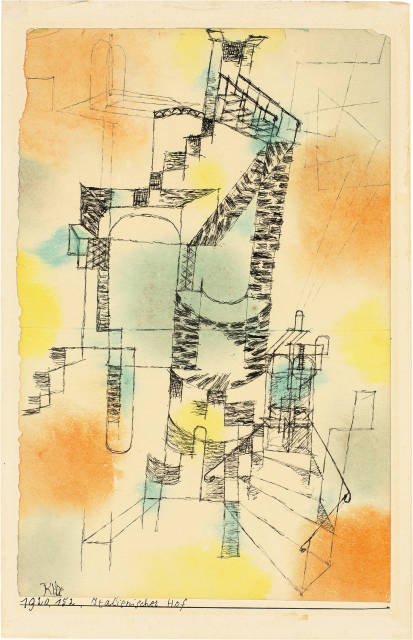- FR
S’inscrire
- Acheter
- Vendre
- Plus
- Galerie
- Commerce d'art
- Maison d'Édition
- Kornfeld aujourd’hui
- L'histoire de la Maison
- Informations






Münchenbuchsee bei Bern 1879 - 1940 Muralto
1920 - work number 1920.152
Ink and watercolour on Canson paper mounted on cardboard
24x15.8 cm, image with text; 27x17.6 cm, cardboard
Signed "Klee" in ink by the artist lower left in the picture, dated below on the support above the final line, with the work number and titled "1920 152 Italienischer Hof"
Paul Klee Foundation, Catalogue raisonné, vol. 3, Works 1919-1922, Bern 1999, No. 2497
Collection Otto Ralfs, Brunswick (from 1931)
Collection Paula Dörner, Krefeld
Collection Edgar Deswatines, Krefeld (until 1978)
Fischer Fine Art, London, Inv. No. CF 5678
Modern Gallery Otto Stangl, Munich
Collection Gianfranco Ambrosini, Verbier (until 1985)
Galerie Beyeler, Basel, inv. no. 10612 (1985-1987), acquired there by
Private collection Switzerland
Bern 1921, Kunsthalle, Alice Bailly et al, cat. no. 240
London 1979, Fischer Fine Art, Paul Klee 1879-1940, cat. no. 12
Munich 1979/1980, Städtische Galerie im Lenbachhaus, Paul Klee - Das Frühwerk 1883-1922, cat. no. 431
Minimally browned. In very good condition and fresh in colour
Towards the end of the First World War, Paul Klee achieved his artistic and commercial breakthrough, supported in particular by Herwarth Walden and his gallery "Sturm". Klee lived with his wife Lily and their son Felix, born in 1907, in Munich, where he joined the Räterepublik (Soviet Republic) in 1919. After its suppression, he fled to Zurich, where he met artists from the DADA movement, including Tristan Tzara, Hans Arp, Marcel Janco and Hans Richter. In May 1920, Klee had his first solo retrospective at the Galerie Goltz in Munich, with 371 works. During a visit to Marianne von Werefkin and Alexej von Jawlensky in Ascona at the end of 1920, Klee received a telegram appointing him as a master at the Bauhaus in Weimar.
It was during this time that he painted "Italienischer Hof". The watercolour is vaguely reminiscent of Piranesi's fantastic architectural structures. The staircases leading to nowhere have a Dadaist, surreal effect, but one can also sense Klee's interest in architecture. The colour accents in orange, yellow and blue make the "architectural structure" seem to float. A very detailed drawing.
1920 - Werknummer 1920.152
Tusche und Aquarell auf Canson Papier, auf Karton aufgelegt
24x15,8 cm, Darstellung mit Schrift; 27x17,6 cm, Unterlagekarton
Unten links im Bild vom Künstler in Tusche signiert "Klee", darunter auf Unterlage über dem Abschlussstrich datiert, mit der Werknummer und betitelt "1920 152 Italienischer Hof"
Paul Klee Stiftung, Catalogue raisonné, Band 3, Werke 1919-1922, Bern 1999,
Slg. Otto Ralfs, Braunschweig (ab 1931)
Slg. Paula Dörner, Krefeld
Slg. Edgar Deswatines, Krefeld (bis 1978)
Fischer Fine Art, London, Inv.
Moderne Galerie Otto Stangl, München
Slg. Gianfranco Ambrosini, Verbier (bis 1985)
Galerie Beyeler, Basel, Inv.
Privatsammlung Schweiz
Bern 1921, Kunsthalle, Alice Bailly et al.,
London 1979, Fischer Fine Art, Paul Klee 1879-1940,
München 1979/1980, Städtische Galerie im Lenbachhaus, Paul Klee - Das Frühwerk 1883-1922,
Minim gebräunt. Farbfrisch und in sehr guter Gesamterhaltung
Gegen Ende des Ersten Weltkriegs gelang Paul Klee der künstlerische und kommerzielle Durchbruch, vor allem gefördert durch Herwarth Walden und dessen Galerie "Sturm". Klee lebte mit seiner Ehefrau Lily und dem 1907 geborenen Sohn Felix in München, wo er sich 1919 der Räterepublik anschloss. Nach deren Niederschlagung floh er nach Zürich und traf dort Künstler der DADA-Bewegung, darunter Tristan Tzara, Hans Arp, Marcel Janco und Hans Richter. Im Mai 1920 fand in der münchener Galerie Goltz die erste retrospektive Einzelausstellung mit 371 Werken statt. Bei einem Besuch in Ascona bei Marianne von Werefkin und Alexej von Jawlensky Ende 1920 erreichte Klee das Berufungstelegramm als Meister an das Bauhaus in Weimar.
In dieser Zeit entstand auch "Italienischer Hof". Das Aquarell erinnert entfernt an Piranesis phantastische Architekturgebilde. Die ins Nichts führenden Treppen wirken durchaus dadaesk-surreal, man spürt aber auch Klees Interesse für Architektur. Die in Orange, Gelb und Blau gesetzten Farbakzente lassen das "Architekturgebilde" förmlich schweben. Eine sehr fein ausgearbeitete Zeichnung.
| Suisse | CHF | 130 |
| Europe | CHF | 230 |
| Outre-mer | CHF | 290 |







